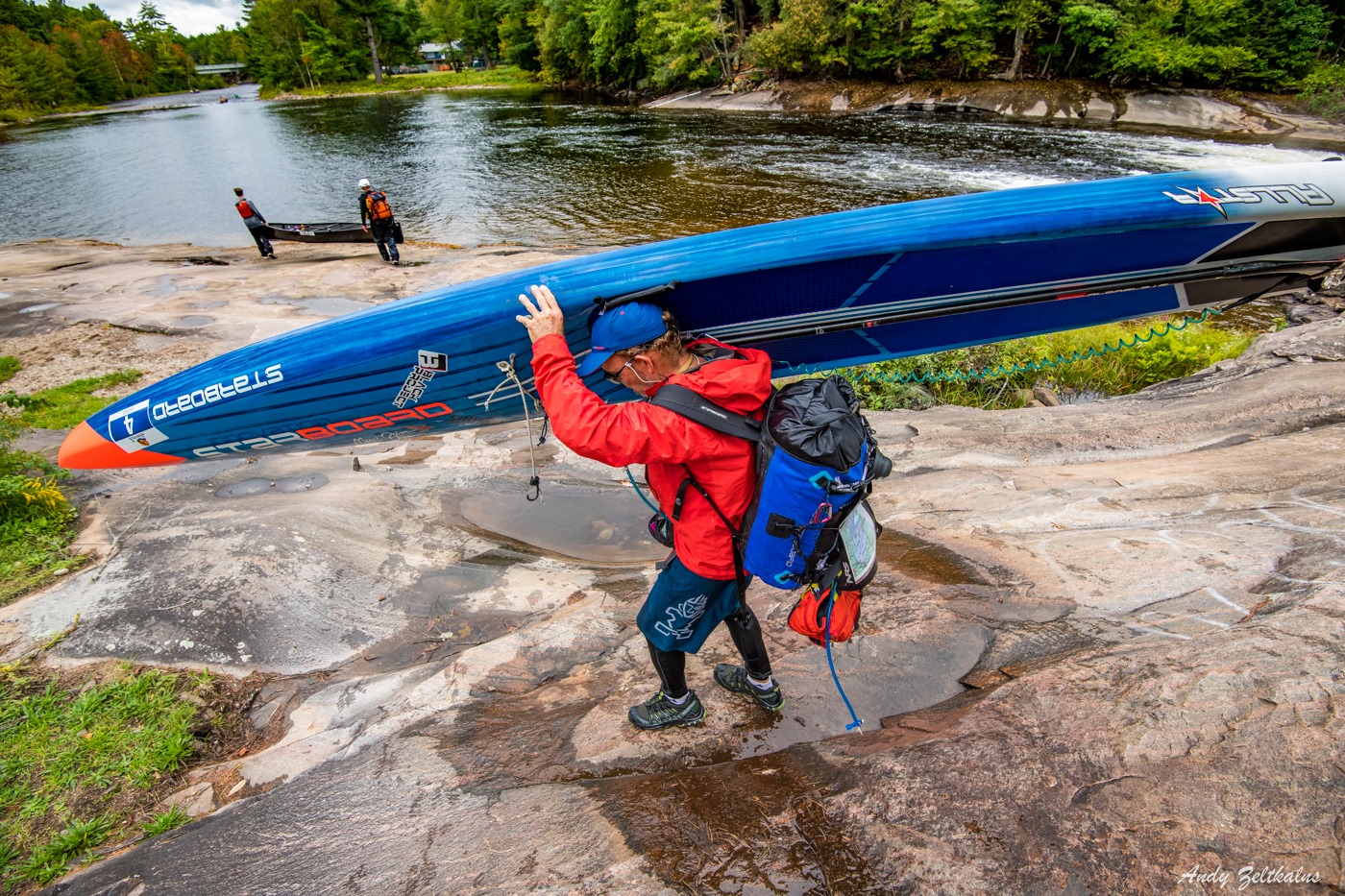
An ultra adventure: “70% of teams didn’t finish” – Bart de Zwart on the ‘Muskoka River X’ challenge
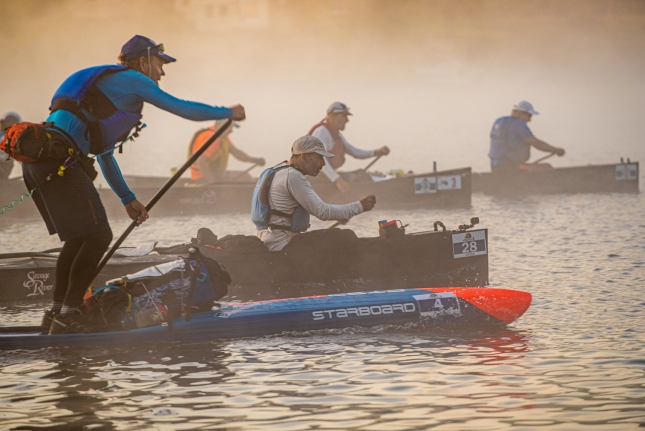
Another ultra adventure in Canada (credit: @limelightmuskoka)
For me, the “X” in this race represents the unknown; you never know what you’re going to get at Muskoka. And that was truer than ever this year, when rough weather forced organisers to cut this “ultra” short after 70% of competitors had already been forced to retire.
Muskoka is not only a paddling event, it’s a genuine adventure race. You have to navigate a labyrinth of lakes, rivers and portages using nothing but a paper map and a compass. There are three options: the 58km “Sprint”, 130km Classic and the 223km, ultra-endurance ‘Coureur des Bois’. I chose the 223.
The portages add a unique element to this race. There are 38 spots where you have to walk or run (sometimes *climb* is more accurate) over land between the waterways. The shortest portage is only 100m but the longest is almost 5km.
So you don’t just paddle this race: at regular intervals you have to pack all your gear back in a dry bag, hoist your board or canoe on your shoulder and make a trek through a forest (or if you’re lucky, along a path) to the next body of water. It’s even more exhausting than it sounds.
Muskoka is definitely not your traditional SUP race. But it’s definitely an experience and one that I recommend to any seasoned paddler.
As with some of the other extreme ultras such as the Yukon 1000, at Muskoka you have to carry all your own gear along the entire course. No outside support or “refueling” is allowed. There are several mandatory items to ensure you’ll be safe for at least two days in the wilderness, but you also have to be careful to keep your gear to a minimum because of all those portages. Every extra bit of weight adds up.
There were 68 teams entered this year but only six stand up paddlers. I sense there is a growing movement towards these “ultras” in the SUP world, but at the same time races like Muskoka and the Yukons are still daunting challenges that aren’t for everybody. Muskoka also clashed with the five-day 11 City Tour this year–September is a particularly busy month for endurance racing (Ultra Month?).
15 teams entered the full two-day course which began at 7am Saturday in the foggy dawn of Whitney.
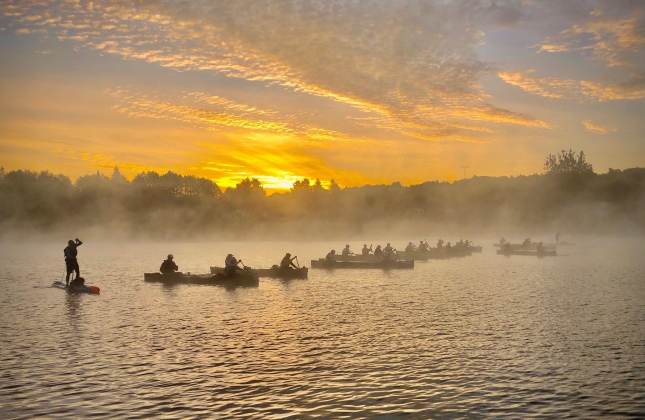
Foggy start to the Coureur des Bois (credit: @limelightmuskoka)
The fog actually wasn’t too bad this year — at least we could see the other side of the first lake (unlike what we’ve experienced in the past where some teams have gotten extremely disoriented and even completely lost in the first few hours). But the weather wouldn’t be on our side for long.
My goal was to reach the mandatory rest stop at the end of day one before nightfall, which meant about 12 hours of steady paddling. The main reason, apart from getting some rest (it doesn’t matter how late you arrive at camp Saturday night because we all depart together at 5:30am Sunday morning) was to avoid running any portages at night. The land crossings are difficult enough in broad daylight but at night become downright dangerous.
The first few hours remained sunny and calm. Everything was going well. I had a good pace and was in a good position even compared to the faster two-man canoes.
I was using the All Star 14 x 24.5. For me it’s the board of choice in the Canadian ultras (Muskoka, the Yukon River Quest and the Yukon 1000) because of the volume and width — you can pack plenty of gear but still glide very fast.
We were warned that the water was extremely low this year, which brings added challenges to the SUP division compared with the finless canoes.
I use a Black Project G10 fin because it’s stronger and you can also sandpaper-out any dings to make it like new again. The fin became critically important because I hit many, many rocks along the way this year. The river was very shallow in many places. We had to be very careful not to hit the bigger rocks and fly off our boards or snap a fin clean in half (I always carry a spare just in case).
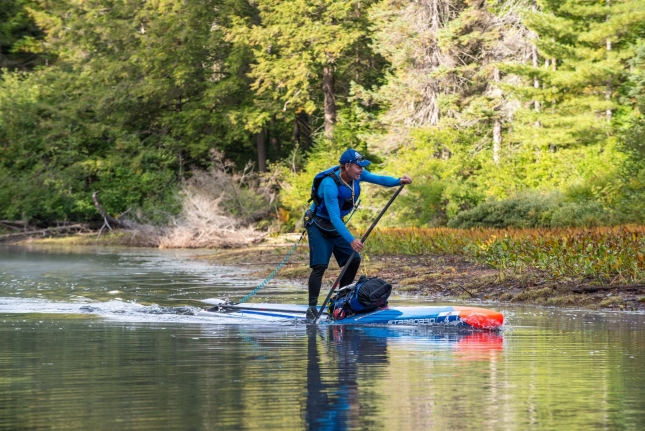
The long, lonely, winding rivers of Muskoka (credit: @limelightmuskoka)
After six hours of paddling and even with the low water levels I was still making good time, but that’s when the wind started picking up and dark clouds rolled over. The rain started with a drizzle but soon became a downpour.
The most important piece of clothing is your rain jacket. I always race with a very good GoreTex jacket — staying dry and warm in a race like this is essential.
Paddling Muskoka is sometimes a never-ending series of twists and turns in the river making the course seem much longer than it appears on paper. A few times the river got so narrow and shallow that I asked myself if I totally misread the map and perhaps got lost.
By 5pm it was already getting dark. Thick clouds strangled the last of the daylight and the campsite was still far away.
When you’re so focused on racing you sometimes forget that you’re paddling in a beautiful part of the world — in a national park no less. I was reminded by this when a moose swam across the river right in front of me. You only realise how enormous they are once they get out of the water on the other side. Beautiful!
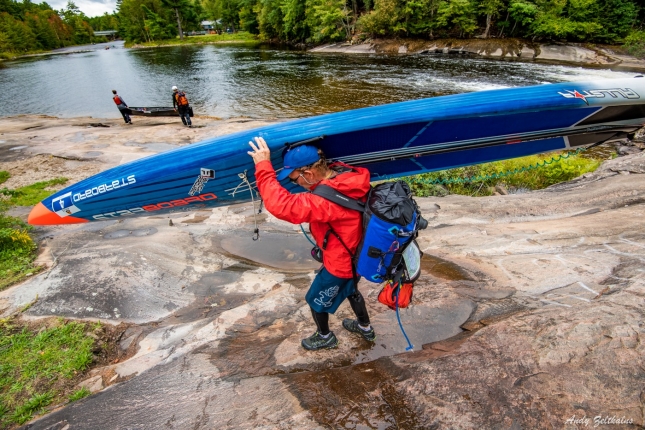
The portages in Muskoka add a new challenge to a SUP race (credit: Andy Zeltkalns
I’d only seen two canoe teams close to me all day but when night fell and it started pouring rain – complete with thunder and lightning in the distance – I was suddenly very alone and carefully finding my way through the final portages. My headlamp didn’t help much because the rain reflected the light.
I finally reached camp at 9pm after 14 hours on the water and with the lightning getting a little too close for comfort in the final kilometres. I limped in like a drowned rat. I was wet, cold and ready for a good meal and quick sleep.
I found some shelter and my good friends in the two-man canoe race, Paul Adams and his 15-year-old son Isaac who had come in ahead of me. We traded stories while making our freeze-dried meals. Soon after, I passed out for a short but deep sleep inside my survival blanket (you have to carry your “home” on your board, remember, and a tent takes up too much room for my liking).
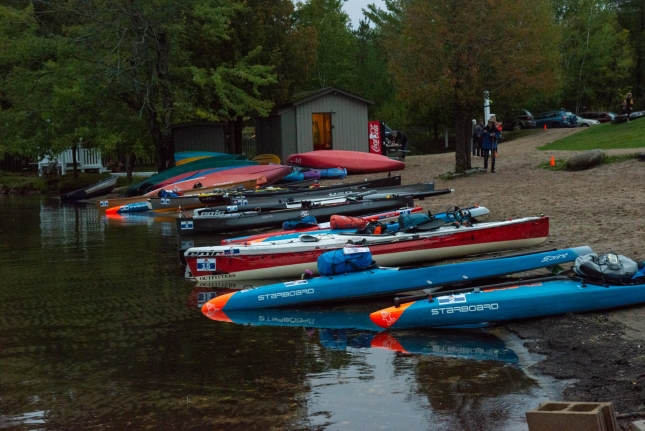
Sunday morning in Muskoka (credit: @limelightmuskoka)
I awoke at 4:30am Sunday morning.
It was only six hours of sleep but I felt as good as new. Physically I was still hurting but mentally I was refreshed, and that’s the most important thing in these ultras.
A short transfer brought us to the start of day two where the “Classic” competitors (130km) joined us on the start line. The weather looked better: cloudy but dry. However the wind was blowing straight in our faces.
I had a great start and felt good until we hit the lake. There’s something about lakes in these ultras that seem to play the role of villain every time. The infamous Lake Laberge in the Yukon River Quest and Yukon 1000, the short but savage “Lake Slotermeer” in the 11 Cities (that part of the stage was canceled completely this year), the seemingly-endless Loch Ness at the Great Glen Challenge in Scotland, and now the dreaded headwind lakes of Muskoka.
Mary Lake. She’s a cruel mistress. Not as long as some of the other ultra villains but just as tough. Mary wasn’t in a good mood this year. The strong headwind was whipping up chop that turned our crossing into a wrong-way-downwinder. I decided to paddle to the far west side of the lake in search of a little shelter. This was a longer route but it saved me priceless energy as the conditions near shore were somewhat more bearable. I don’t think I could have made it straight across that lake on my SUP.
Later I heard that 10 teams were rescued on Mary Lake. Many canoes capsized and got stranded. It was a rough morning.
I eventually limped off the lake having wasted much of the energy I was reserving for later that day. I had paid a price to cross Mary, and so for the next half an hour I took it easy in an attempt to recharge while still moving. There was still a long way to go.
Back in the relatively protected river passage, the wind was still against us but far more manageable than on open waters.
The portages aren’t just there to provide an additional challenge–they’re essential for safely navigating the river. This became clear when I watched a two-man canoe miss a portage and get swept over the falls. They had to swim to the river bank to regroup and retrieve their gear. I helped collect a few pieces that were floating away and then I was on my way again.
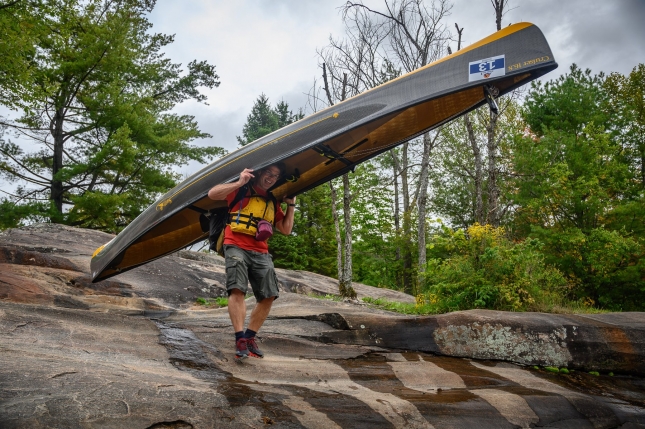
If you thought carrying a SUP over a portage was tricky… (credit: @limelightmuskoka)
I’d lost a lot of time on Sunday morning and worried about the 4pm cut-off at the next checkpoint. I ran as fast as I could around the last portage – a dam with a waterfall – and then had exactly 11 minutes to reach the town of Braceridge.
I glanced at my watch as often as I could while picking up my pace into full race mode. I hit the marker with three minutes to spare, but this wasn’t the finish line I was looking for. It was already mid-afternoon and there was still a long way to the traditional finishing point. I knew it was going to be a long night.
I kept eating and drinking at regular intervals to keep myself fueled. This is one of the most critical parts of an “ultra” and something that’s a lot harder than it sounds. Just the physical act of chewing becomes difficult after 24 hours of paddling.
Finally we were pointing in the right direction for the wind. But just as I felt a few tiny little downwind bumps, the dark closed in and the wind disappeared.
It was around nightfall when organisers informed me that one of the final portages in the town of Baysville would be the new finish line due to the extreme conditions and dwindling field. At that point I didn’t mind if it was “only” going to be a 188km race.
When the dark had set in, I teamed up with Paul and Isaac for the slow journey home. The river was particularly shallow at this point and at times it was difficult to find water to plant our blades in. Finding the portages in the dark was just as difficult and crossing them even more so. Your speed through portages drops to a snail-pace at night.
With a bit of cursing and a lot of help from a full moon and clear skies, we found our way through each land barrier and slowly inched towards the end. If it wasn’t for the sleep deprivation and pure exhaustion, we might have better appreciated how beautiful that evening sky was.
Just before 1am, now into our third day of racing, we arrived at the forward finish line. After starting Saturday morning, the shortened course took me more than 32 hours. That’s slower than what the entire, 35km-longer course usually takes. It was a slow year.
We soon found out that only 20 of the 68 teams had reached the finish and that I was the only SUP still standing. Some retired, some were forced to retire. The latter group included Mike Crouzat who’d been paddling strong but who was heart-breakingly forced out after narrowly missing a strict cut-off time. I’d avoided the same fate by just a few minutes.
Special mention also goes to Danielle Holdsworth who tackled the Coureur des Bois on a Starboard Sprint. She was forced to abandon on the first night during the wild thunderstorm when her time was running out but she did very well in her first ultra.
The 2019 edition will be remembered as one of the toughest years of Muskoka X.
Due to the conditions, a stand up paddleboard was certainly not the easiest craft for this race, but I heard many paddlers say they plan to attempt the SUP division next year. The organisers are working on a new route for next year and will also introduce two- and four-person inflatable divisions. That will make for an interesting new class. It also won’t be quite so lonely on the lakes.
Thank you to Mike Varieur and Rob Horton for making this race happen. It’s an extreme test for us as paddlers but surely even tougher for these two organisers who work tirelessly all year and then sleep probably less than anyone during race weekend.
If you’re looking for a real adventure then add the Muskoka River X race to your bucket list.
Long live the ultras.
Thanks to my sponsors Starboard along with Patagonia, Black Project fins, SupSkin, Maui Jim, Robijns bv, Camelbak, Suunt, Kanaha Kai Maui and my biggest supporter of all, my beautiful wife Dagmar.
Follow @muskokariverx on Instagram and Facebook for more coverage.
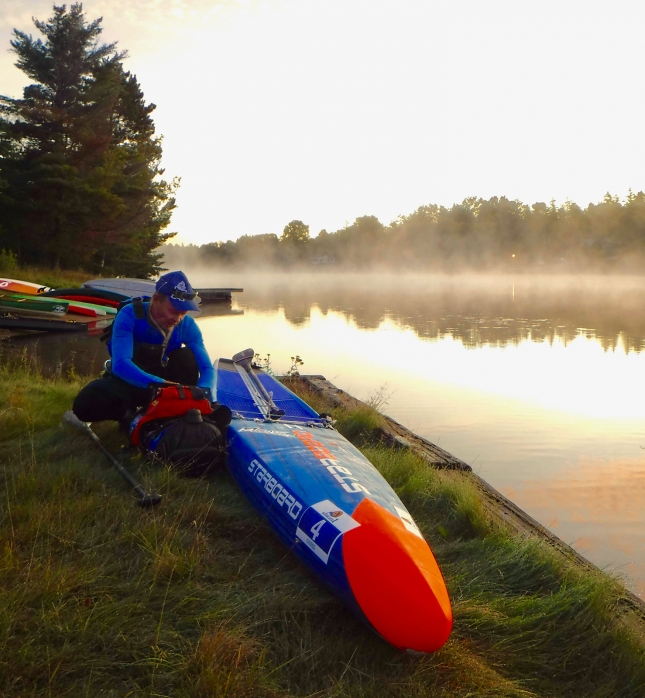
My trusty Starboard All-Star has completed another ultra. This board has probably seen more racing miles than most… (photo: Mike Varieur)
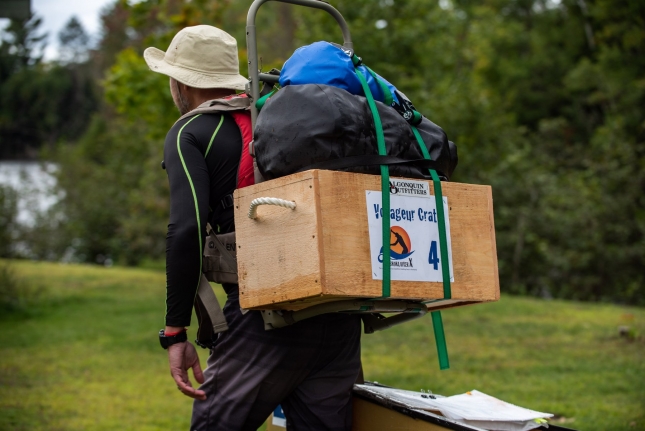
The crate: Competitors can purchase a pre-packed box of survival gear on the condition you carry the entire crate with you just like the old-school voyageur canoes in this part of the world. I thought it was a really cool idea, but I couldn’t bring myself to lug around a wooden box for two days… (credit: @limelightmuskoka)



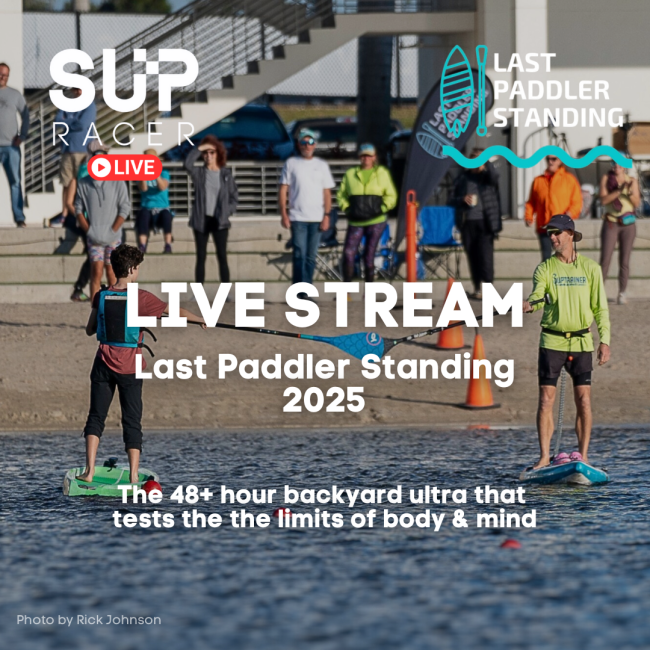
You must be logged in to post a comment.